Moïse Kisling
Moïse Kisling, born Mojżesz Kisling (January 22, 1891 – April 29, 1953), was a Polish-born French painter.[1] He moved to Paris in 1910 at the age of 19, and became a French citizen in 1915, after serving and being wounded with the French Foreign Legion in World War I. He emigrated to the United States in 1940, after the fall of France, and returned there in 1946.
Moïse Kisling | |
|---|---|
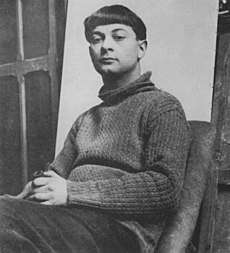 Moïse Kisling, c.1916 | |
| Born | Mojżesz Kisling 1891 Kraków, Grand Duchy of Cracow, Austria-Hungary |
| Died | 1953 (aged 63) Sanary-sur-Mer, France |
| Nationality | Polish, French |
| Known for | Painting |
Early life and education
Born in Kraków, Austria-Hungary, he studied at the School of Fine Arts in Kraków. His teachers encouraged the young man to go to Paris, France, considered the international center for artistic creativity in the early 20th century.
Career
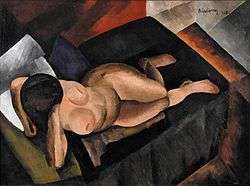
In 1910, Kisling moved to Montmartre in Paris, and a few years later to Montparnasse; he joined an émigré community made up of artists from eastern Europe as well as Americans and British. Most of the French kept to themselves, although the artistic community was international.
At the outbreak of World War I, he volunteered for service in the French Foreign Legion. After being seriously wounded in 1915 in the Battle of the Somme, he was awarded French citizenship.[2]
Kisling lived and worked in Montparnasse, where he was part of its renowned artistic community. For a short time he lived in the Bateau-Lavoir in Montmartre, and in 1911–12 spent nearly a year at Céret.
%2C_oil_on_canvas%2C_82_x_61.7_cm%2C_private_collection.jpg)
In 1913 he returned to Montparnasse, where he took a studio and lived for the next 27 years. The artists Jules Pascin and later Amedeo Modigliani lived in the same building. He became close friends with many of his contemporaries, including Modigliani, who painted a portrait of him in 1916 (in the collection of the Musée d'Art Moderne de la Ville de Paris). His style in painting landscapes is similar to that of Marc Chagall. A master at depicting the female body, his surreal nudes and portraits earned him the widest acclaim.
Kisling volunteered for army service again in 1940 during World War II, although he was 49. When the French Army was discharged at the time of the surrender to the Germans, Kisling emigrated to the United States. He rightly feared for his safety as a Jew in occupied France. He exhibited in New York City and Washington. He settled in California, where he lived until 1946.
Under the Vichy government, certain critics suggested too many foreigners, especially Jews, were diminishing French traditions.[3] Their comments were part of a rise in anti-Semitism during the German occupation, resulting in French cooperation in the deportation and deaths of tens of thousands of foreign and French Jews in concentration camps.
Kisling returned to France after the war and defeat of Germany. Moïse Kisling died in Sanary-sur-Mer, Var, Provence-Alpes-Côte d'Azur, France on April 29, 1953. A residential street in the town is named after him.
Paintings
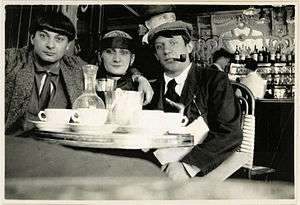
A large collection of Kisling's works is held by the Musée du Petit Palais in Geneva, Switzerland. Some of his paintings:
- Nu assis (Kiki de Montparnasse)
- Woman in black dress, National Museum of Serbia
- Portrait de Madeleine Lebeau
- Woman in a Shawl
- Paysage de Sanary
- Spanish Woman
- Jeune femme blonde
- Femme nue assise
- Nu allongé
- Port de Tamaris
- Portrait de jeune fille brune
- Buste nu couché
- Woman in an Interior
- La sieste à Saint-Tropez, autoportrait avec Renée
Gallery
- Works
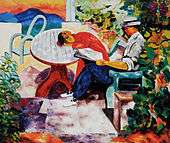 Moïse Kisling, 1916, La Sieste à Saint-Tropez (Kisling with Renée)
Moïse Kisling, 1916, La Sieste à Saint-Tropez (Kisling with Renée)%2C_oil_on_canvas%2C_81.3_x_60.3_cm%2C_private_collection.jpg) Moïse Kisling, Portrait du peintre (Autoportrait), oil on canvas, 81.3 x 60.3 cm, private collection. Published in Action: Cahiers Individualistes de Philosophie et d’art, July 1920
Moïse Kisling, Portrait du peintre (Autoportrait), oil on canvas, 81.3 x 60.3 cm, private collection. Published in Action: Cahiers Individualistes de Philosophie et d’art, July 1920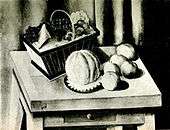 Moïse Kisling, Nature morte, before 1920. Reproduced in André Salmon, L'Art Vivant, Artistes d'hier et d'aujourd'hui, 1920 (black and white photograph)
Moïse Kisling, Nature morte, before 1920. Reproduced in André Salmon, L'Art Vivant, Artistes d'hier et d'aujourd'hui, 1920 (black and white photograph)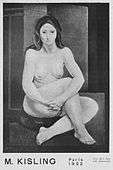 Moïse Kisling, 1921, Nu assis, oil on canvas, private collection
Moïse Kisling, 1921, Nu assis, oil on canvas, private collection%2C_Action%2C_Cahiers_Individualistes_De_Philosophie_Et_D%E2%80%99art%2C_August_1921.jpg) Moïse Kisling, Nature morte (Still Life), published in Action, Cahiers Individualistes De Philosophie Et D’art, August 1921
Moïse Kisling, Nature morte (Still Life), published in Action, Cahiers Individualistes De Philosophie Et D’art, August 1921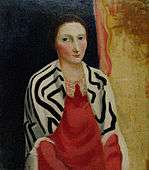 Moïse Kisling, Portrait of Rénée Kisling
Moïse Kisling, Portrait of Rénée Kisling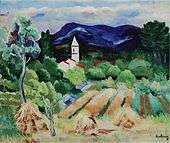 Moïse Kisling, c.1919, Paysage de Provence, oil on canvas
Moïse Kisling, c.1919, Paysage de Provence, oil on canvas
- Depictions of the artist
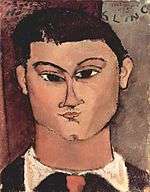 Portrait of Kisling by Amedeo Modigliani
Portrait of Kisling by Amedeo Modigliani- Amedeo Modigliani, Portrait of Moïse Kisling, 1918. Lille Métropole Museum of Modern, Contemporary and Outsider Art, Villeneuve d'Ascq, France
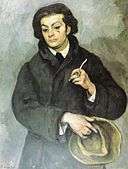 Roman Kramsztyk (1885-1942), Portrait of Moïse Kisling, 1913
Roman Kramsztyk (1885-1942), Portrait of Moïse Kisling, 1913 Pablo Picasso and Moïse Kisling in Paris, photographed by Jean Cocteau, 12 August 1916
Pablo Picasso and Moïse Kisling in Paris, photographed by Jean Cocteau, 12 August 1916 Moïse Kisling, 1941
Moïse Kisling, 1941

References
- Pologne Michelin, - 2009 "Kisling de Montparnasse - Né dans une famille juive à Cracovie, Moïse Kisling (1891-1953) fut l'élève de "
- "ULAN Full Record Display, Kisling, Moïse". Getty Research. The J. Paul Getty Trust. Retrieved 2017-07-16.
- Elizabeth Campbell Karlsgodt, Defending National Treasures: French Art and Heritage Under Vichy, p. 44 (2011) Quote: "..the prominence of foreign Jewish artists such as Chaim Soutine, Michel Kikoine, and Moïse Kisling. As a result, certain art critics such as Camille Mauclair claimed that foreign artists were contaminating the French artistic tradition."
External links
- Works by or about Moïse Kisling at Internet Archive
- Agence photo de la Réunion des musées nationaux RMN
- Moïse Kisling in American public collections, on the French Sculpture Census website
